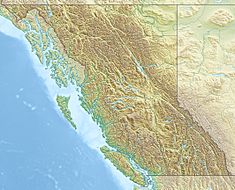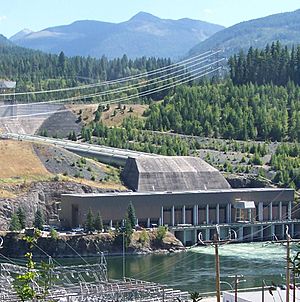Kootenay Canal facts for kids
Quick facts for kids Kootenay Canal |
|
|---|---|
|
Location within British Columbia
|
|
| Official name | Kootenay Canal Generating Station |
| Location | Kootenays, British Columbia, Canada |
| Coordinates | 49°27′10″N 117°31′05″W / 49.45278°N 117.51806°W |
| Opening date | 1976 |
| Reservoir | |
| Creates | Kootenay Lake |
| Surface area | 38,900 ha (389 km2) |
| Power station | |
| Operator(s) | BC Hydro |
| Hydraulic head | 84m |
| Turbines | 4 |
| Installed capacity | 588 MW |
| Capacity factor | 48.2% |
| Annual generation | 2482 GWh |
The Kootenay Canal is a special place in British Columbia, Canada, where we make clean electricity from water! It's a big hydroelectric power station located about 19 kilometers (12 miles) from the city of Nelson, British Columbia. Here, water from the Kootenay River is sent through a special canal to power huge machines. This power station, called the Kootenay Canal Generating Station, started making electricity in 1976. It was built because other dams, like the Duncan Dam and Libby Dam, helped make sure there was always enough water flowing into Kootenay Lake for power.
Contents
How the Kootenay Canal Works
The Kootenay Canal uses the power of flowing water to create electricity. This process is called hydroelectricity. It's a clean and renewable way to get power.
Water Diversion
Water for the Kootenay Canal comes from a reservoir created by the Corra Linn Dam. Instead of letting all the water go over the old dam, a large canal guides it. This canal is about 4.5 kilometers (2.8 miles) long. It helps the water bypass several older, smaller power plants. By doing this, the Kootenay Canal can use the water more effectively. It gets a bigger drop in height (called hydraulic head) and uses newer machines to make more electricity.
The Powerhouse
After traveling through the canal, the water drops 84 meters (276 feet) down into the powerhouse. Inside the powerhouse are four giant machines. Each machine has a water turbine connected to an electrical generator. The force of the falling water spins the turbines, which then spin the generators to make electricity.
Once the water has passed through these powerful machines, it flows back into the Kootenay River. The electricity made at the Kootenay Canal plant is sent out through big power lines. These lines connect to BC Hydro's main power system, which supplies electricity to homes and businesses across British Columbia.
Making More Power
In 1999, the four turbines at the Kootenay Canal were upgraded. This made them even more powerful! The total electricity output increased to 583 megawatts (MW).
Together, the Kootenay Canal and the Seven Mile Generating Station are very important. They provide about 10% of all the electricity that BC Hydro needs for the province.
Agreements for Water Flow
The Kootenay Canal's success is partly thanks to a special agreement called the Columbia River Treaty. This treaty helps manage the flow of water in the Columbia River system. Because of dams like the Duncan Dam and the Libby Dam (which is in Montana, USA), there's a steady supply of water flowing into Kootenay Lake all year round.
This constant water supply is good for all the power plants downstream. The Kootenay Canal is allowed to use water that would normally go through five older power plants owned by FortisBC and the City of Nelson. In return, FortisBC gets paid for the amount of power their plants would have made. Other dams, like the Brilliant Dam, Seven Mile Dam, and Waneta Dam, are also part of this important agreement.



